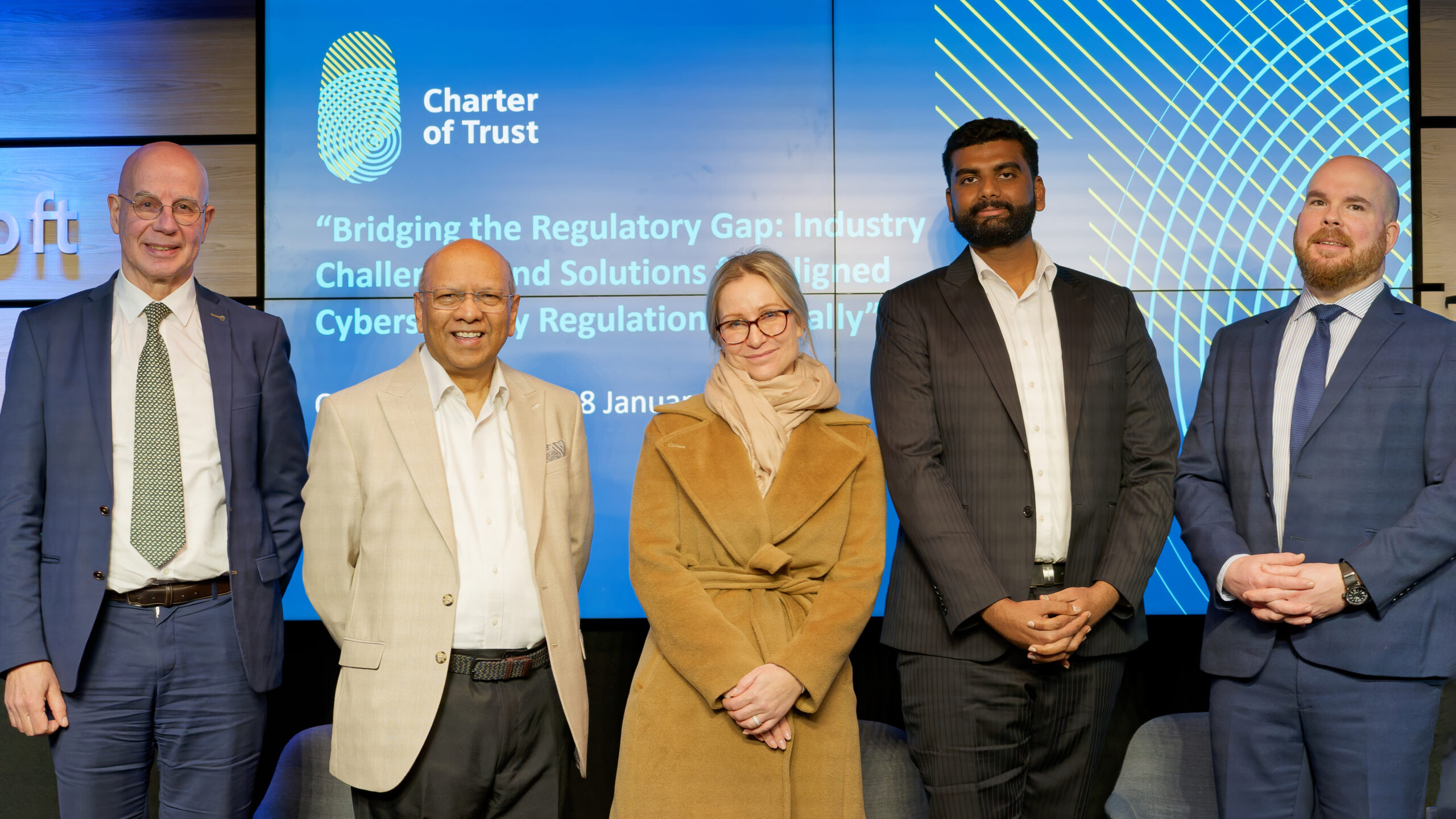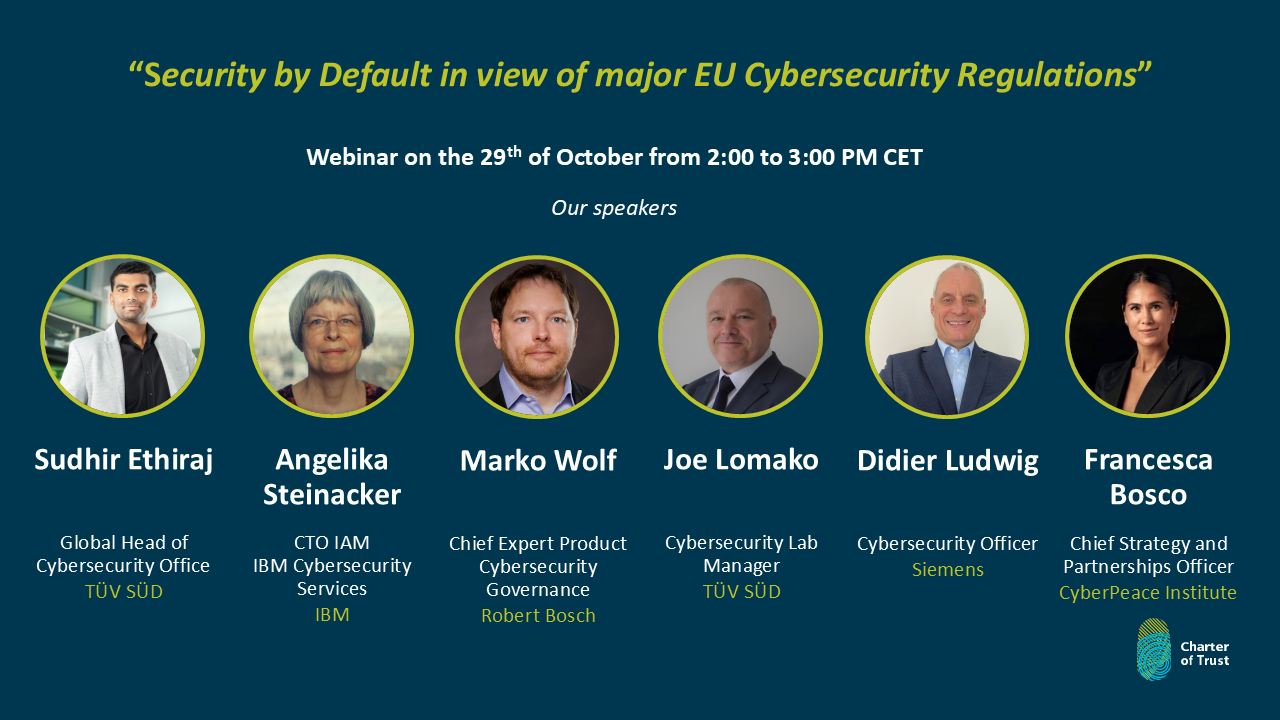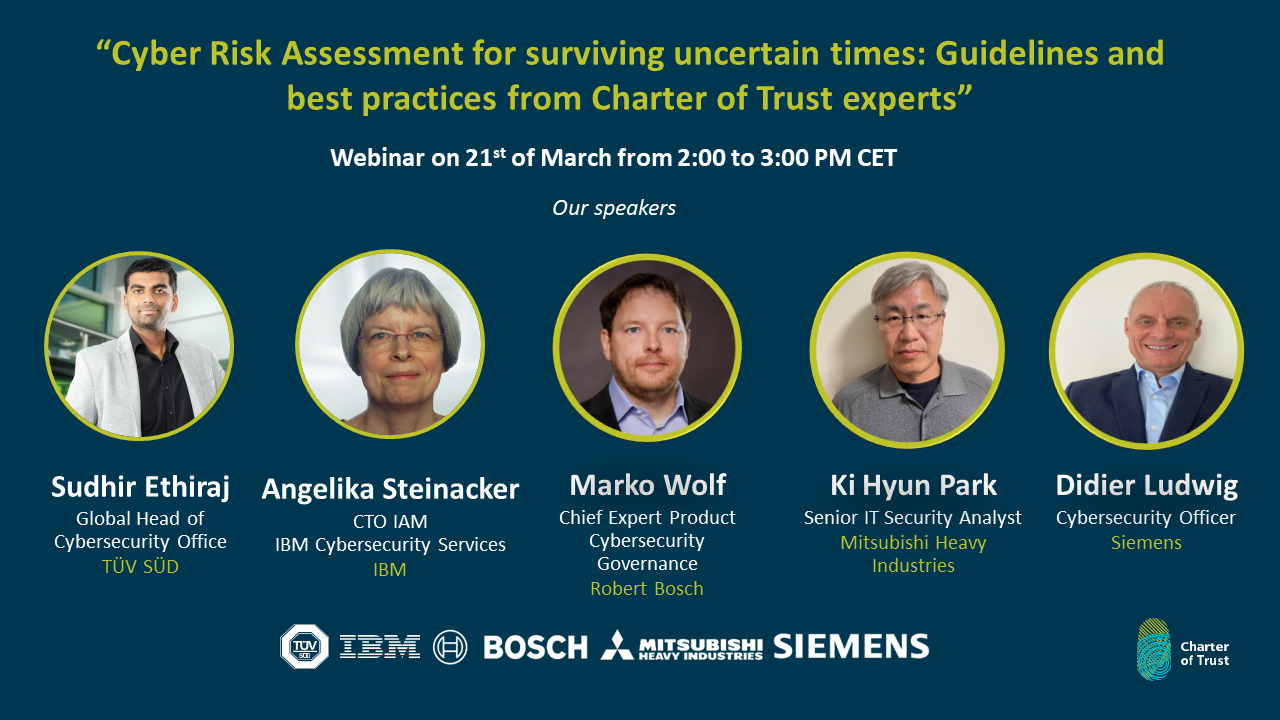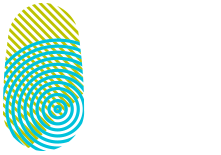On 29 October, the Charter of Trust Principle 8 ‘Transparency and Response’ hosted its first-ever webinar on the cybersecurity threat landscape with leading experts in the field. The session started with an overview of the 2020 threat landscape, examined how the Charter of Trust is sharing threat information among its members through its Human-to-Human network and by building a threat information sharing community supported by a leading platform.
The session was introduced by Jonathan Sage, Government and Regulatory Affairs Executive at IBM and Principle 8 Taskforce Lead. Launched in 2018, the Charter of Trust aims to drive security in an insecure, connected world and all of its members collaborate to implement the Charter’s 10 Principles. The Principle 8 Taskforce ‘Transparency and Response’ aims to achieve the following objectives:
- Establish appropriate corporate policies that allow threat information sharing for individuals within the CoT;
- Establish a strategic and operational threat information response forum within the CoT;
- Leverage an existing platform that allows threat information sharing, therefore augmenting awareness and enabling scaling to supply chain.
Kevin Albano, Associate Partner at IBM Security X-Force Threat Intelligence, presented the current threat landscape amid the COVID-19 pandemic. The global proliferation of ransomware puts companies worldwide at higher risk as they are facing “Human-Operated” Ransomware-as-a-Service operations. Following the payment of a ransom, threat actors are further motivated to increase both the number of attacks and the price of the ransom itself.
This was followed by an industry panel discussion moderated by Jonathan Sage:
- Holger Steinlechner, Senior Security Specialist at Allianz, provided insight on the provenance and challenges of threat information sharing. Companies share indicators of compromise, knowledge and insights into incidents to improve their defenses against attackers. Among the prerequisites, trust is an essential component of threat information sharing.
- Regarding the Internet of Things (IoT), Hans de Jong, Senior System Architect and Fellow at NXP, highlighted that the hardware and the firmware cannot be updated easily or at all. Therefore, incidents must be shared with trusted entities who are affected or have to take action.
- Karl Alles, Group Security Officer at Atos, noted that the increasing complexity of the supply chain and very well-organized adversaries require a timely availability of threat information. Within the Principle 8 Taskforce, members exchange regularly as part of the Human-to-Human Network using the Information Sharing Traffic Light Protocol (ISTLP) adapted for the CoT.
Choo Kim-Isgitt, Chief Revenue Officer at TruSTAR, presented the TI sharing platform used within the Human-to-Human Network, which features enclaves to manage various sources with cloud-based data repositories. As illustrated by the City of Los Angeles CyberLab, private enclaves are also made available for each member.
The audience. which was comprised of governmental and industry stakeholders from around the world as well as fellow CoT representatives, was invited to share their thoughts and questions with our panelists throughout the discussions and during our Q&A session.
To hear the full discussion between our experts, make sure to check-out the recorded webinar above and stay tuned for more Charter of Trust webinars coming soon!


You may also like

CyberTrust Talk returns to Brussels - Bridging the Regulatory Gap – Industry Challenges and Solutions for Aligned Cybersecurity Regulations Globally
Following the resounding success of its inaugural event, the CyberTrust Talk is making a much-anticipated return for its second edition. This exclusive gathering brings together renowned experts, influential industry leaders, and key policymakers to delve into some of the most pressing issues in the world of cybersecurity. The focus of this year’s event is centered on “Bridging the Regulatory Gap – Industry Challenges and Solutions for Aligned Cybersecurity Regulations Globally.”
With an increasingly interconnected world, harmonizing cybersecurity regulations has become a critical challenge. This event provides a platform for exploring innovative solutions and fostering dialogue on how to address these challenges effectively. Participants engage in the exploration of real-world case studies and actionable approaches designed to bridge the regulatory divide, particularly between Europe and the United States.
The CyberTrust Talk is more than just a discussion—it is a unique opportunity to engage with leading minds who are shaping the future of cybersecurity. Guests hear from distinguished speakers offering their expertise and perspectives, as well as gain insights into the latest trends and strategies shaping global cybersecurity policies. Beyond the thought-provoking conversations, the event also provides a space for meaningful networking, with a standing lunch offered during the first half of the day to encourage connections among attendees.
This year’s exceptional lineup of speakers includes Christiane Kirketerp de Viron, Acting Director at DG CNCT of the European Commission; Paul Timmers, Research Associate at the University of Oxford; Jean-Marc Leclerc, Director of IBM EU Policy; and Sudhir Ethiraj, Global Head of Cybersecurity Office at TÜV Süd. The discussions will be guided by the experienced moderation of Dr. Sumit Chanda, Global CISO at Eviden and Chair of the GEE Working Group of the Charter of Trust. Opening remarks will be delivered by Jeremy Rollison, Senior Director of Microsoft European Government Affairs, setting the stage for an inspiring and impactful afternoon.


“Security by Default in view of major EU Cybersecurity Regulations”
🔒 Here the main points of discussion:
- Key insights into what NIS2, the European Cyber Resilience Act and other regulations mean for businesses
- Best practices for adapting to relevant regulations
- Expert strategies on how to deal with regulatory challenges
- Live Q&A with industry experts
Here the esteemed panelists
Sudhir Ethiraj, Global Head of Cybersecurity Office, TÜV SÜD (Moderator)
Dr. Angelika Steinacker, CTO IAM, Cybersecurity Services, IBM
Marko Wolf, Chief Expert Product Cybersecurity Governance, Bosch
Joe Lomako, Cybersecurity Lab Manager, TÜV SÜD
Didier Ludwig, Cybersecurity Officer, Siemens
Francesca Bosco, Chief Strategy and Partnerships Officer, CyberPeace Institute
Please find the recording of the webinar below. Follow us on LinkedIn to find out, when the next webinar is going to happen: https://www.linkedin.com/company/charter-of-trust


Webinar: Cyber Risk Assessment for surviving uncertain times: Guidelines and best practices from Charter of Trust experts
The Charter of Trust consists of 10 Principles and this webinar is brought to you by the Charter’s Taskforce on Principle 3 “Security by Default”. Experts in this taskforce work to establish and adopt the highest appropriate level of security and data protection and ensure that it is preconfiguered into the design of products, functionalities, process, technologies, operations, architectures, and business models. We call this our Baseline Requirements: With them in mind, you can ensure confidentiality, authenticity, and integrity within your systems.
In this webinar, you will learn about the objectives, scope and benefits of risk assessment. Our experts Sudhir Ethiraj (TÜV SÜD), Angelika Steinacker (IBM), Marko Wolf (Bosch), Ki Hyun Park (Mitsubishi), and Didier Ludwig (Siemens) will share best practices with insights and examples on the roles, timing, methods, and standards involved in risk assessment.
We look forward to welcoming you at this virtual event.



